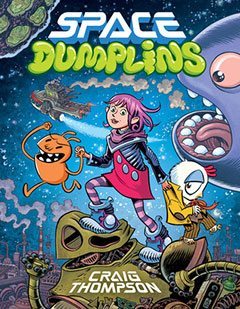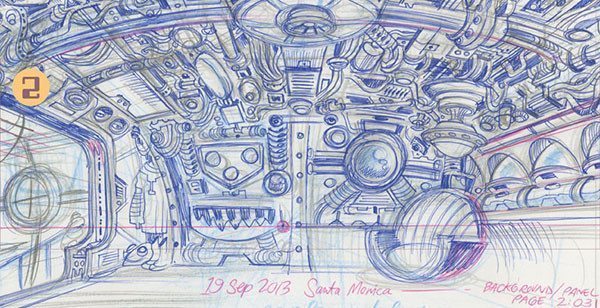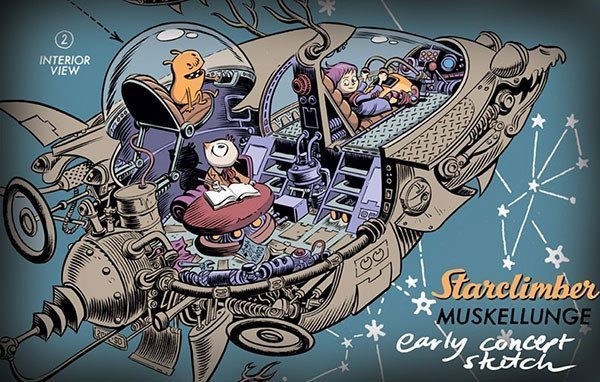 by Vicki Palmquist
by Vicki Palmquist
I’ve just finished reading the graphic novel Space Dumplins by Craig Thompson, with color by Dave Stewart (Graphix, 2015). I am overwhelmed by the work that went into this book. First off, it’s an engrossing, turn-the-page story with an appealing cast of characters. As readers, we care about what will happen. That’s a good start.
Now, imagine that you are sitting down with a pencil to sketch one of the spreads in this book. Perhaps you’ve picked the pages where Violet, our heroine, first gets a look at SHELL-TAR, the interior of the space station. You start by drawing the intricacies of the gleaming steampunk time clock and then you draw all of the activity going on inside the transparent transport tubes, large enough to accommodate personal spaceships. Next you fill in the many habitats, the globular trees, the people at the beach. Then you insert our cast of characters into the scene along with the robotic Chaperdrone (a babysitter). Whew. That’s a lot of drawing for two pages.
Of course, you’re providing this as a backdrop for the fast-paced story of three new friends, quick-witted, learning to work as a team, doing their best to save the people they love and their corner of the universe. You’ve already written the story, the script, and worked through the surprises that will delight your readers, making it a tight and believable hero’s journey set in the Mucky Way.
Violet, Zacchaeus, and Eliot are unlikely heroes except that Violet has a welcoming heart, a brave outlook on adventure, and an optimism as big as outer space. She can see qualities in her new friends that they can’t see themselves. Eliot, the chicken, is studious, introverted, widely read, and somewhat psychic. Zacchaeus, the last of the Lumpkins (well, almost the last, because space whales ate his planet) is chaotic, impulsive, and ready for a fight. All three of the friends are good at problem-solving, especially when they work together. The military can’t defeat the space whales: they can only clean up after them. It’s these three who figure out the true heart of the problem.

Once you’ve sketched all of this, applied ballpoint pen, then brushed ink, you ask someone else to color everything in. Together, you’re creating a book full of these story-telling images, richly colored, highly detailed, and ultimately believable as a look at life that’s really happening somewhere “out there.”
The rest of the main cast of characters include Violet’s parents, the reformed felon Gar and the fashion designer Cera, Gar’s fishing buddies Mr. Tinder and crew, Cera’s boss at the Fashion Factory, Master Adam Arnold, and the most inventive space vehicles I’ve ever seen. Every being (they’re not all human) in this book has a unique look. No cookie-cutter, repetitive characters to save on drawing time.
It’s a movie set on paper, except that you’ve had to conceive of, write, draw, and color every bit of it. There are no cameras and crew to bring your vision to life. Exhausted yet?
Even the endpapers are attention-riveting. The constellations fill the skies of Space Dumplins and they often make an appearance, reminding us that we share the same space even though the setting feels alien and wondrous.

You know those kids who are constantly doodling in class? They’ll love this book. And the kids who stay up long past their bedtimes trying to finish a chapter? They’ll love this book. And the kids who don’t know what to read next but they don’t want it to be boring? Yup, they’re gonna love it. Space Dumplins reads like a TV series, a movie, a video game, and a solid, exciting story all between book covers. Brilliant.
Asides:
Be sure to notice the homage to a number of cultural icons in this book. H.A. Rey’s The Constellations? Strange Brew? Spaceballs? And the real Trike (it exists!).
Be sure to read Craig Thompson’s answers to Five Questions on The Book Rat’s blog. You’ll find out how long it took him to create Space Dumplins.
For a look at what Craig Thompson is working on and where he’s appearing, visit his website.
